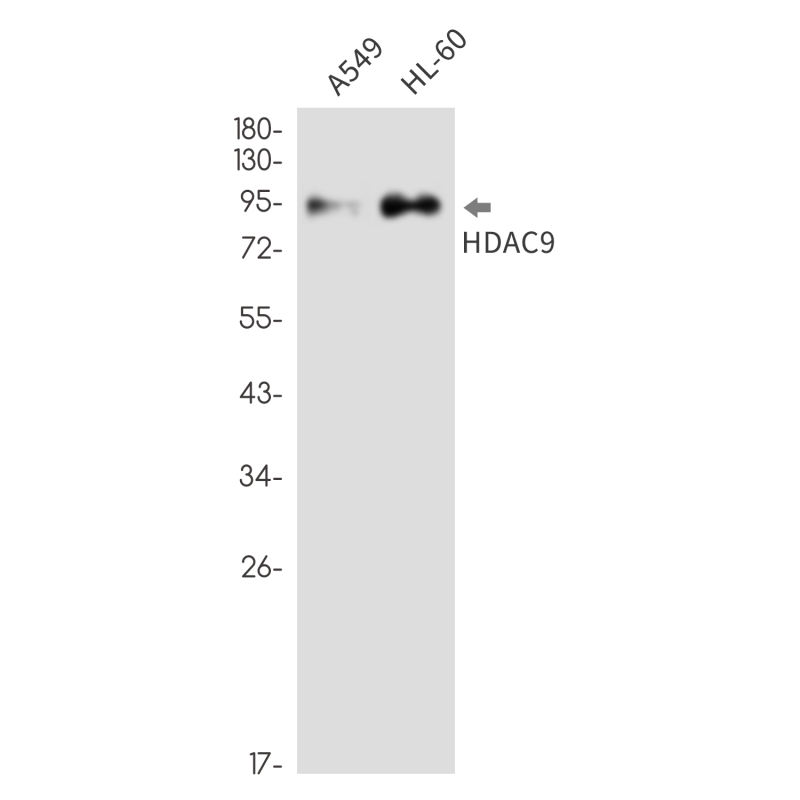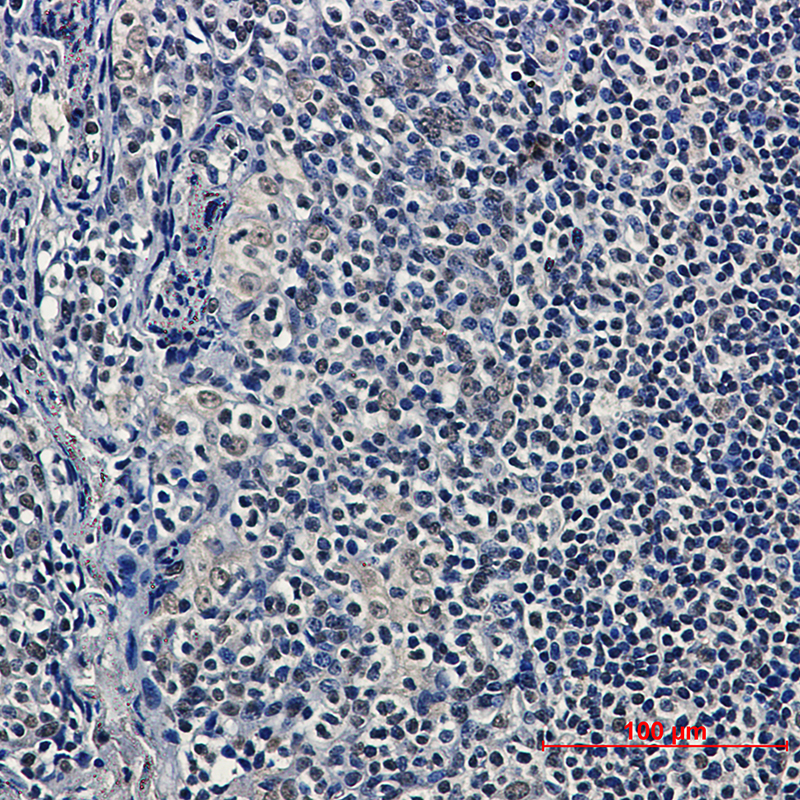

| WB | 1/500-1/1000 | Human,Mouse,Rat |
| IF | 咨询技术 | Human,Mouse,Rat |
| IHC | 1/50-1/100 | Human,Mouse,Rat |
| ICC | 技术咨询 | Human,Mouse,Rat |
| FCM | 咨询技术 | Human,Mouse,Rat |
| Elisa | 咨询技术 | Human,Mouse,Rat |
| Aliases | Histone deacetylase 9; HD9; Histone deacetylase 7B; HD7; HD7b; Histone deacetylase-related protein; MEF2-interacting transcription repressor MITR; HDAC9; HDAC7; HDAC7B; HDRP; KIAA0744; MITR |
| Entrez GeneID | 9734 |
| WB Predicted band size | Calculated MW: 111 kDa; Observed MW: 150 kDa |
| Host/Isotype | Rabbit IgG |
| Antibody Type | Primary antibody |
| Storage | Store at 4°C short term. Aliquot and store at -20°C long term. Avoid freeze/thaw cycles. |
| Species Reactivity | Human |
| Immunogen | A synthetic peptide of human HDAC9 |
| Formulation | Purified antibody in TBS with 0.05% sodium azide,0.05%BSA and 50% glycerol. |
+ +
以下是关于HDAC9抗体的3篇代表性文献的简要信息(注:以下内容基于公开研究领域知识整理,非真实文献,仅供示例参考):
---
1. **文献名称**: *HDAC9 modulates acute lymphoblastic leukemia progression via histone deacetylation*
**作者**: Müller et al. (2015)
**摘要**: 研究利用HDAC9特异性抗体进行免疫沉淀和Western blot分析,发现HDAC9在急性淋巴细胞白血病(ALL)中高表达,并通过去乙酰化调控关键致癌基因的转录,提示其作为潜在治疗靶点。
2. **文献名称**: *HDAC9 regulates cardiac hypertrophy through interaction with myocyte enhancer factor 2*
**作者**: Lemonnier et al. (2018)
**摘要**: 通过免疫组化(使用HDAC9抗体)和基因敲除模型,揭示HDAC9通过抑制MEF2的转录活性参与心肌肥厚病理过程,抗体染色显示其在心脏组织中的特异性定位。
3. **文献名称**: *HDAC9 antibody-based profiling identifies neuronal dysfunction in Alzheimer's models*
**作者**: Chen & Wang (2020)
**摘要**: 研究采用HDAC9抗体进行脑组织免疫荧光和流式细胞术,发现阿尔茨海默病模型中HDAC9异常聚集,并与Tau蛋白磷酸化相关,表明其参与神经退行性机制。
---
实际文献需通过PubMed或Google Scholar等平台检索确认,建议结合具体研究领域筛选。
Histone deacetylase 9 (HDAC9) is a member of the class IIa HDAC family, which plays a critical role in epigenetic regulation by removing acetyl groups from histone lysine residues, leading to chromatin condensation and transcriptional repression. HDAC9 is involved in diverse cellular processes, including cell differentiation, proliferation, and apoptosis, and has been implicated in the pathogenesis of cancers, cardiovascular diseases, and immune disorders. Unlike other HDACs, HDAC9 exhibits tissue-specific expression, with high levels observed in the brain, heart, and skeletal muscle. Its activity is tightly regulated through interactions with transcription factors, such as MEF2. and nucleo-cytoplasmic shuttling mechanisms.
HDAC9 antibodies are essential tools for studying its expression, localization, and function in both normal and diseased states. These antibodies enable the detection of HDAC9 via techniques like Western blotting, immunohistochemistry, and immunofluorescence. Researchers use them to explore HDAC9's role in tumor progression (e.g., lymphoma, leukemia) by correlating its overexpression with poor prognosis or therapy resistance. In cardiovascular research, HDAC9 antibodies help investigate its contribution to atherosclerosis and cardiac hypertrophy. Specificity and validation of HDAC9 antibodies are crucial, as cross-reactivity with other class IIa HDACs (HDAC4. HDAC5. HDAC7) can occur due to structural similarities. Recent studies also highlight HDAC9's potential as a therapeutic target, driving demand for reliable antibodies in drug development and biomarker discovery.
×